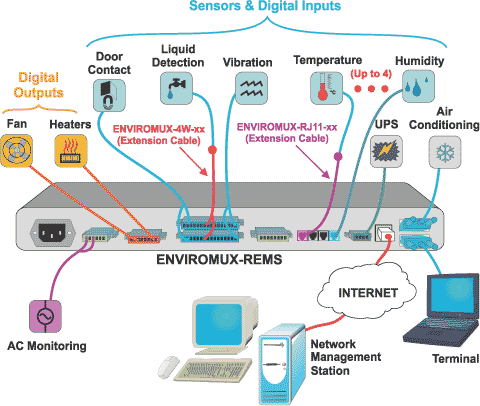Also known as: Remote Environment Monitoring System, monitor computer rooms, server room monitoring,
temperature sensor, humidity sensor, computer room temperature, room alert.
Features & Applications |
The Server Environment Monitoring System monitors critical environmental conditions, such as temperature, humidity, water, motion, intrusion, and vibration. When a sensor exceeds a configurable threshold, the system will notify you via email, LED, buzzer, LCD, and network management (SNMP).
- Monitor and manage server room environmental and security conditions over IP.
- Create alarm signals with customized input parameters.
- Internal power supply for all sensors.
- Access Authorization System requires an external power supply (included).
|
- Operates and configures via SNMP, HTTP, TELNET or V.24 terminals.
- Supports SMTP protocol.
- Alerts are sent using email and SNMP traps when any monitored environmental condition exceeds a user-specified range.
- Alerts are posted in message log, which is accessible through RS232 and Web user interface.
- Sends email notifications of alerts to a maximum of eight email addresses.
- Generates syslog messages.
- 1RU rack mount case is standard.
|
Specifications |
 |
1. Power Port
- 110 or 230 VAC at 50 or 60 Hz via IEC connector.
- Connection for Earth Ground.
- Fuse protection.
2. AC Voltage Monitoring Connections
- Three screw terminal pairs for connecting three AC voltages.
- Potential-free, no common ground reference.
- Input voltage: 50-255 VAC.
3. Digital Outputs
- Four screw terminal pairs.
- Potential-free relay switch contacts.
- Maximum switching load: 1.5 A at 230 VAC, 2 A at 30 V DC.
- Individually fuse protected.
4. Digital Inputs
- Eight screw terminal groups (of four terminals) for connecting dry contact devices.
- Potential-free.
- Input voltage: +5 V DC to +25 V DC.
- With auxiliary +12 V DC supply, maximum current draw of 200 mA.
- Fuse protection.
5. Alert Inputs
- Four screw terminal pairs for connecting four signals or dry contact devices.
- Maximum drawable alarm current approximately 20 mA.
6. Digital Inputs Temperature/Humidity
- Four RJ11 modular jacks for connecting temperature sensors, humidity sensors and/or combined temperature/humidity sensors.
7. UPS Input
- Two screw terminal pairs for connecting UPS switching outputs.
- Input voltage: +5 V DC to +25 V DC.
8. Ethernet Port
- One 10 Base-T Ethernet port with RJ45 Ethernet connector.
9. AUX Port
- One male DB9 RS232 serial port for controlling and monitoring external equipment, such as the Access Authorization System or an air conditioner.
10. COM Port
- One male DB9 RS232 serial port for terminal access.
|
ProtocolsDimensions
- WxDxH (in.): 19x9.1x1.75
- Weight: 8.5 lbs.
Regulatory ApprovalsEnvironmental
- Operating temperature: 41°F to 104°F (5°C to 40°C).
- Operating and Storage Relative Humidity: 5 to 85% non-condensing RH.

|
Control Methods |
- Configuration can be done using the front panel interface, through direct connection to the serial port (RS232), or over the Internet/LAN via Web page or Telnet.
Front Panel Interface
- Use front panel buttons to move through LCD screens and execute actions.
- LEDs indicate the following:
- "Fault" (red) lights up in connection with Reset, Overload or a serious system fault.
- "Warning" (yellow) lights up if a sensor exceeds a configurable threshold, when booting and in connection with Reset.
- "Power" (green) lights up when the device is supplied with voltage.
- One RJ11 communication socket for connection to a PC or terminal (male RJ11 to female 9-pin RS232 serial communication cable included).
RS232 Control
- Serial baud rate: 9600bps.
- Data format: 8 data bits without parity, 1 stop bit.
- Software handshake.
Telnet
- Simple parameter configuration and evaluation of equipment data using Telnet.
- Security is ensured by password.
|
- Set thresholds for warning and alarm conditions.
- View sensor status.
- View message log.
- Up to 99 users can access the web page at one time.
Administrative Controls
- "Read-Only" or "Read/Write" privileges can be assigned to each user.
- "Read-Only" users cannot save changes or access administration functions.
- View and/or modify user passwords and parameters.
- Change/disconnect users, administrators, passwords, etc.
- A maximum of 99 users can be created.
Network Configuration
- When the system is integrated into a local network, the following functions are available:
- SNMP support, allowing integration into network management platforms.
- Log book functional capabilities (syslog service).
- Loading and saving the system configuration (TFTP).
- Updating the system (TFTP).
|



